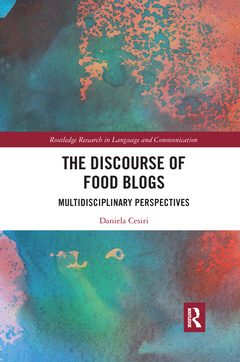The Discourse of Food Blogs Multidisciplinary Perspectives Routledge Research in Language and Communication Series
Auteur : Cesiri Daniela

**Winner of the AIA (Associazione Italiana di Anglistica) Book Prize 2022 (Senior)**
This volume adopts a multidisciplinary perspective in analyzing and understanding the rich communicative resources and dynamics at work in digital communication about food. Drawing on data from a small corpus of food blogs, the book implements a range of theoretical frameworks and methodological approaches to unpack the complexity of food blogs as a genre of computer-mediated communication. This wide-ranging framework allows for food blogs? many layered components, including recipes, photographs, narration in posts, and social media tie-ins, to be unpacked and understood at the structural, visual, verbal, and discourse level in a unified way. The book seeks to provide a comprehensive account of this popular and growing genre and contribute to our understandings of digital communication more generally, making this key reading for students and scholars in computer-mediated communication, multimodality, critical discourse analysis, corpus linguistics, and pragmatics.
Contents
List of figures
List of tables
Acknowledgments
Introduction
0.1. The language of/on food: state of the art
0.2. Blogs as narrative places to talk about food
0.3. This book
Part 1. Food Blogs: Introduction and Genre Analysis
Chapter One. Blogs and blogging. Origins, development and state of the art in linguistics and communication studies
1.1. Introduction
1.2. Origins and development of blogs
1.2.1. The digital divide and the ‘blogger’ profile
1.3. Blogs as (virtual) communities
1.4. Blogs as a genre of computer-mediated communication (CMC)
1.5. Socio-cultural issues in blogs
1.6. Blogs and the other web 2.0 media
1.6.1. Why study blogs?
1.7. Conclusions: blogs in this book
Chapter Two. Food blogs as a genre of computer-mediated communication
2.1. Introduction
2.2. Food blogs: overview and state of the art
2.2.1. Food blogs as communities
2.2.2. State of the art
2.3. The corpus
2.3.1. The food bloggers: profiles and demographics
2.4. Defining food blogs as a web-mediated genre
2.5. Genre theory and genre analysis
2.6. Genre analysis of the UK-FBs corpus
2.6.1. Searching for structural patterns: the ‘About Pages’
2.6.2. Searching for structural patterns: the ‘Recipes Sections’
2.7. General remarks
Part Two. Visual Analysis
Chapter Three. The visual analysis of food blogs
3.1. Introduction
3.2. Multimodal analysis: theoretical-methodological framework
3.2.1. Multimodal analyses of hypertexts and their application to food blogs
3.3. Multimodal analysis of the UK-FBs corpus: the homepages
3.4. Multimodal analysis of the UK-FBs corpus: the ‘About Pages’
3.5. Multimodal analysis of the UK-FBs corpus: the ‘Recipes Sections’
3.6. General discussion: metafunctions in the UK-FBs corpus
Part 2. Verbal Analysis
Chapter Four. The verbal discourse of food blogs: qualitative and quantitative analyses
4.1. Introduction
4.2. The UK-FBs corpus: stylistic description
4.3. Qualitative analysis
4.3.1. Key keywords in the ‘Recipes Sections’ sub-corpus
4.3.2. Miscellaneous keywords and their collocations
4.4. Sensory language in he UK-FBs corpus
4.4.1. The language of food and its appeal to the senses
4.4.2. Sensory language in the ‘Recipes Sections’ of the UK-FBs corpus
4.4. Lexical priming in food blogs
4.5. Final remarks
Part four. (Critical) Discourse Analysis and Pragmatic Implications
Chapter Five. Food blogs as spaces of social interaction (and pragmatic implications). Critical analysis of the ‘About Pages’ and of the ‘Comments Sections’
5.1. Introduction
5.2. Theoretical framework
5.2.1. The ‘About Pages’ as spaces of unequal power relations
5.3. Politeness and FT-/FSAs in the ‘Comments Sections’
5.4. Shaping virtual personae in the UK-FBs corpus
5.5. Final remarks
Conclusions
References
Index
<
Daniela Cesiri is Associate Professor in English Language and Translation in the Department of Linguistics and Comparative Cultural Studies at Ca’Foscari University of Venice, Italy.
Date de parution : 09-2021
15.2x22.9 cm
Date de parution : 02-2020
15.2x22.9 cm
Thème de The Discourse of Food Blogs :
Mots-clés :
Food Blogs; TBB; Daniela Cesiri; Key Keywords; pragmatics; MFE; English for Specific Purposes; MML; corpus linguistics; Recipes Sections; sensory language; Social Media Icons; multimodality; Flax Seeds; lexico-grammar; Lexical Priming Theory; CDA; Tv Chef; critical discourse analysis; Reference Corpus; narrative studies; Multimodal Analysis; digital communication; In-group Identity; food bloggers; BNC; Computer Mediated Communication; CMC; Research Article; computer-mediated communication; Sensory Adjectives; discourse of food blogs; Semantic Preferences; BIC Score; Lexical Priming; Car Model; Reading Pathways; Prime Machine; Open Source Software



